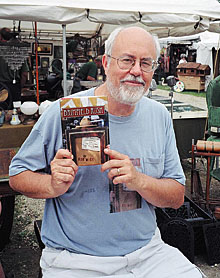  |
| HOME | THIS ISSUE | CALENDAR | GRANTS | BACK ISSUES | < BACK | NEXT > |
New book captures thrill of collecting through tales of Brimfield dealersby Sherry Fisher - July 24, 2006 |
||||
| When Bob Wyss first drove down rural Route 20 to the Brimfield Antique and Collectibles Show, he couldn't believe his eyes. "I was flabbergasted," he says. "It went on for a mile and for as far as you could see. To the right and to the left were booths and tables and trucks with stuff heaped everywhere. Some of it looked interesting, some of it looked valuable, and a lot just looked like junk." Wyss, an assistant professor in the journalism department, wanted to know more about what was going on in this quaint New England village of about 3,300 people, that on a hot day in July was packed with thousands more. Three times a year, for a week in May, July, and September, some 30,000 dealers, collectors, and bargain hunters descend on the sleepy town of Brimfield, Mass., for what is perhaps the largest outdoor flea market in the country. Wyss, who was looking for writing projects, started talking to dealers and collectors. "They had wonderful stories to tell about the goods they were selling," he says. "I knew I had to write a book about it." Before coming to UConn in 2002, he was a reporter and editor for the Providence Journal for 28 years. Brimfield Rush: The Thrill of Collecting and the Hunt for the Big Score follows the adventures of a handful of dealers at Brimfield from May 2003 through May 2004. It focuses on a couple from Philadelphia, Joe Laskowski and Rachel McKay, who are struggling to make it in the art business. "I wanted to write a narrative nonfiction book," he says. "To do that right, it has to have a real plot structure with a narrative tension and conflict and climax and resolution. Joe and Rachel fit the bill. "Joe wheels and deals all the time," Wyss says. "He'll buy a painting for 100 bucks and 'flip' it for 200 bucks in two hours. He has an incredible, encyclopedic knowledge of American art and history." Wyss found Rachel McKay interesting because of her love of art and her reluctance to part with her paintings. In a chapter called "The Toothache," Rachel finds out she needs a root canal procedure that will cost $2,000. "She's in pain, and looks around the house," Wyss says. "She's got paintings everywhere. They're cash poor but inventory rich. Should she sell a painting and have the root canal, or keep the painting and have the tooth pulled? She decides to have the tooth pulled." Rachel and Joe, who have a new mortgage on an old farmhouse and dream of opening an art gallery, have got to find something they can buy cheap and sell for a lot of money. They need to find the "big score."
Wyss says there is an "intense social network that occurs at Brimfield - not only between dealers, but among customers too. The dealers are there from all over the country three times a year.There's a special camaraderie that occurs. Then there are networks and relationships they have with customers. If you start to go there for any period of time - and I've been out there since 2002 - you really get to know people pretty well." One of the first people Wyss met was Joel Schift, a one-legged collector of cast-iron cookware. "Everyone told me I should talk to Joel," he says. Schift's apartment in New York is packed with the stuff. "I don't know how many items were there," says Wyss, "maybe several thousand. And that was just a third of the collection. This cast iron thing is virtually his life. He got into this particular pastime about 30 years ago and has done tremendous amounts of research on the history and the development of cast-iron cookware and how it significantly changed the kitchen throughout the world." Wyss says the kind of reporting he had to do for the book - "saturation reporting" - requires spending a lot of time with people. "You have to build an incredible trust relationship," he says. "I was hanging around with 10 or 12 dealers for a long period of time. We'd spend time at Brimfield, and I'd talk to them on the phone a lot." He also visited some people several times. If there was one problem he had in writing the book, it is was deciding whose story to tell. "I had so many rich stories, and so many wonderful characters," he says. Wyss says that eBay and the Internet have had a significant impact on antique markets like Brimfield. "There's no doubt that fewer people go to these shows now," he says. "For a lot of people, eBay is a very attractive option. But it doesn't have the color and flavor of shows like Brimfield. And if you're buying a one-of-a-kind rare item, you want to physically inspect it. So as desirable as it is, and as big of an impact as it had on antique markets like Brimfield, eBay hasn't shut them down and probably won't." Wyss says the book should be helpful to his students. "I'm trying to teach my students about quality narrative journalism," he says . "I believe that narrative story telling is going to be an important element of the future. Journalism is going through a huge transition right now. Its credibility has been shaken by scandals, and circulation is down. Newspapers are probably considered more endangered than any other medium because of the Internet." |
| ADVANCE HOME UCONN HOME |

